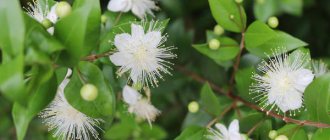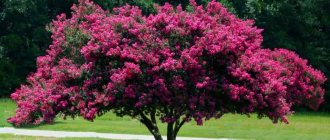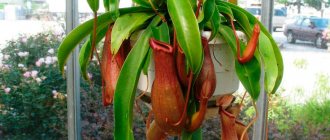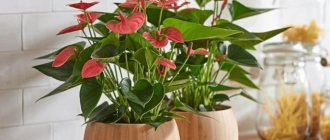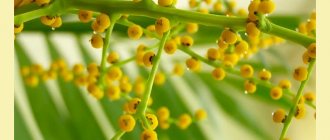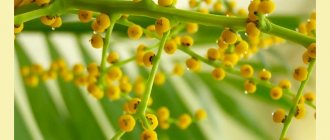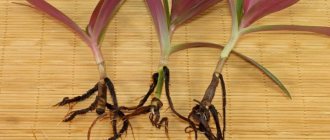Author: Elena N. https://floristics.info/ru/index.php?option=com_contact&view=contact&id=19 Category: Houseplants Published: February 02, 2019Last edits: January 11, 2021
- The myrtle has dried up
- Properties of myrtle
- Common myrtle (Myrtus communis)
plant (lat. Myrtus) belongs to the genus of evergreen woody plants of the Myrtaceae family, the flowers of which contain essential oil. The natural habitats of myrtle are the Mediterranean, the Azores and the north of the African continent. It is no coincidence that the name of the plant is consonant with the Greek word “myrrh”, which means “balm, liquid incense”, because it is as a cult attribute that myrtle essential oil has long been used in temples of various concessions. Legend says that Adam, expelled from Eden, brought the myrtle flower with him to Earth as a memory of the lost paradise. Many peoples have many myths, beliefs, traditions, rituals and signs associated with this plant. The myrtle tree has long been considered a symbol of glory, peace and hope. Our ancestors had myrtle flowers not only for cult purposes, but also for medical and cosmetic purposes, and some myrtle preparations are still popular today. But for plant lovers, a blooming and fragrant myrtle is an object of admiration and a source of aesthetic pleasure, especially since home myrtle is undemanding in care, and those who know how to care for myrtle can easily achieve the optimal shape for a plant that will decorate your home and help preserve To your health.
Planting and caring for myrtle
- Flowering: June-July.
- Lighting: bright sunlight until noon, then bright diffused light (southern, western and eastern windows).
- Temperature: in summer – normal for residential premises, in winter – 5-10 ˚C.
- Watering: in summer - frequent and plentiful; in cool seasons, watering is reduced.
- Humidity: high. Daily spraying of leaves is recommended, especially in hot weather.
- Feeding: from March to August once a week with complex mineral fertilizers.
- Dormant period: winter; in cool conditions - up to three months, in normal conditions - a month and a half.
- Replanting: young plants - annually, adults as needed.
- Pruning: after flowering or early spring.
- Reproduction: cuttings, less often seeds.
- Pests: scale insects, aphids, spider mites, whiteflies, mealybugs.
- Diseases: root rot.
Read more about growing myrtle below.
Brief description of cultivation
- Bloom . In the first half of the summer.
- Illumination . The light should be bright, but diffused.
- Temperature regime . In the spring-summer period - from 18 to 20 degrees, and in winter the room should be no warmer than 10 degrees, but it is better if it is about 5 degrees.
- Watering . From spring to autumn, the plant should be watered abundantly immediately after the top layer of the soil mixture in the container dries. During cold wintering, watering should be very scarce and infrequent, but the earthen clod should not be allowed to dry out completely.
- Air humidity . Throughout the growing season, systematically moisten the bush from a sprayer with lukewarm water. There is no need to spray it in winter.
- Fertilizer . In the spring-summer period, myrtle is regularly fed once every 7 days, for this purpose complex mineral fertilizer is used. There is no need to feed it in winter.
- Rest period . Observed in winter. If the bush is located in the northern part of the room, then the duration of the dormant period will be about 3 months, and if placed in the southern part of the apartment, its duration will be about 6 weeks.
- Trimming . Formative pruning is carried out every year at the beginning of the growing season.
- Transplant . Young bushes need to be replanted every year, while adult bushes need to be replanted once every 2 or 3 years.
- Soil mixture . Sand, peat, clay, turf and humus soil in a ratio of 1:2:2:2:2. For planting, you can also use a substrate consisting of sand, peat, humus and turf soil, with all components taken in equal parts.
- Reproduction . By cuttings and seed method.
- Harmful insects . Whiteflies, mealybugs, scale insects, thrips and spider mites.
- Diseases . Problems when growing myrtle can arise if watering rules are violated or due to excessively dry air.
- Properties . Myrtle is considered a healing plant, which in its effectiveness can compete with antibiotics.
Myrtle. Planting and care.
Botanical description
Myrtle, which according to various sources has from forty to one hundred species, in its natural habitat can grow up to three meters in height, and indoor myrtle, under the most favorable conditions, reaches only a meter. Usually myrtle at home is a tree with a round crown 30-60 cm tall. Small leathery, as if polished, leaves of myrtle are located on the shoots sparsely and oppositely on short petioles, they have an elongated shape, the tops of the leaves are pointed. Flowers, simple or double, are either single or collected in a raceme. The fruit is a nut or drupe berry.
An interesting fact is that myrtaceae include such valuable plants for humanity as tea tree, eucalyptus, and clove tree.
Indoor myrtle - description
Interesting fact: the word myrtle is of Greek origin. Translated as “incense.” This shrub actually has many uses, such as its leaves are used to make an essential oil with a pleasant, soothing scent.
Interestingly, myrtle essential oil is used not only to enjoy its aroma, but also for treatment: for example, it calms the nerves and helps fight colds. Berries also help - they make tasty, aromatic decoctions for the sick.
The plant that Europeans are accustomed to calling myrtle is in fact only one of the representatives of the large myrtle family, which also includes feijoa, cloves, and eucalyptus. By the way, most of these plants are also used to produce essential oils.
It is interesting that this is the only member of the family that is widespread and thrives in Europe; the rest of the myrtleaceae are Asian guests.
What does a myrtle tree look like?
It is a shrub reaching approximately two meters in height. The crown is easily formed, so the bush is often stylized as a bonsai (this is called “on a trunk,” that is, the crown is cut so that a thick trunk remains at the bottom, and branches and foliage form a ball at the top).
The leaves are large, bright green, oval, leathery, glossy. The berries are round, dark blue or black, sometimes white (depending on the variety), and contain small seeds inside. Often used to make decoctions, they are tasty and aromatic.
Homeland of the plant
Mediterranean countries. Wild myrtle grows in southern Europe: in Italy, Cyprus, France, Spain, and also in Asia.
How and when does myrtle bloom?
The period from buds to flowering is mid-spring. It begins to bloom directly at the beginning of summer and ends at the end of September - October. Making it bloom is quite simple, just take care of it and also provide the plant with fresh air. It is also important not to prune the bush while it is blooming, but to cut it only when flowering is over.
The flowers are medium in shape, the number of petals is from four to six, warm white-yellow, fragrant. Sometimes they are terry.
How quickly it grows at home
Slowly: it adds only ten to fifteen centimeters annually.
What smells
A characteristic, recognizable smell that is difficult to compare with anything else, except perhaps with eucalyptus, a relative of myrtle. The smell is fresh, herbaceous, soothing. It is often used in men's perfumes, as well as for the production of calming essential oils.
What does myrtle symbolize?
The plant is closely associated with Christian culture, although it is also present, for example, in Ancient Greek or Old Norse. According to Christian tradition, Adam and Eve took myrtle from Eden when the Lord allowed them to take something as a souvenir of the Garden of Eden, of a blissful, cloudless life. Adam and Eve decided that a branch of a bush from Eden would remind them that a person’s soul should be pure, righteous, and also protect their home.
Another biblical legend says that during the Great Flood, Noah sent a dove to find out if there was dry land nearby. One day the dove returned with a sprig of myrtle in its beak - which means the Flood was over.
In the ancient Greek tradition, the myrtle wreath was worn by Aphrodite and her companions, the beautiful Graces, personifying fun, feminine attractiveness, and the pleasures of life.
It is even believed that it was in such a wreath that Aphrodite appeared before Paris when he was ordered to judge the dispute between the three goddesses about who was destined for the famous apple of discord, which became the beginning of the Trojan War. As you know, the goddess of love won, so from then on she fell in love with myrtle, and people often began to plant it around her temples.
Hymen, the god of marriage, and Erato, the muse of erotic poetry, were often depicted with a myrtle wreath.
Since myrtle is associated with the goddess of love, a wreath of it was often adorned on the heads of brides at weddings in ancient Greece and Rome. To this day, brides sometimes choose this type of decoration. Such a wreath symbolizes eternal love, marital fidelity, but besides them, it also symbolizes success, youth, health, strength, and even victory in war.
Is myrtle poisonous or not?
Absolutely not, it is a medicinal plant that is used for medicinal purposes, for example, to calm the nervous system or strengthen the immune system.
Myrtle in nature
Not particularly different from domestic varieties, only wild myrtle is less decorative, because decorative varieties were purposefully bred to please the eye. It grows in Mediterranean countries, for example, Italy, Spain, France, and Cyprus.
Growing myrtle from seeds
How to propagate myrtle by seeds at home? At the beginning of spring, myrtle seeds are sown on the surface of a substrate consisting of equal parts of sand and peat, in a container 7-10 cm deep, sprinkled on top with a layer of the same substrate 3-5 mm thick and, covered with glass, kept at a temperature of about 20 ºC, ventilating and moistening the crops, as well as removing condensation from the glass.
- Monstera: how to care, types and varieties
Shoots appear in a week or two, and when the seedlings grow 2-3 true leaves, they are planted in the same substrate in individual pots so that the root collar remains above the soil surface. A month after picking, the seedlings are fed with nitrogen fertilizer of weak consistency.
However, amateur breeders should know that myrtle grown from seeds:
- will bloom no earlier than in 4-5 years;
- is unlikely to retain varietal characteristics.
In addition, the germination of myrtle seeds sharply decreases after just a year of storage, and obtaining them is problematic, since this will require artificial pollination of the plant.
Reproduction methods
Growing from seeds
Fill the container with soil mixture; seeds should be evenly distributed on its surface, sprinkled with a thin layer of the same substrate. For sowing, use a soil mixture consisting of sand and peat or peat and vermiculite. Sowing of seeds is carried out in a soil mixture, which is pre-watered and then spilled with a solution of a fungicidal preparation. The crops are covered with glass (film) on top, they are systematically ventilated, watered if necessary and kept in a cool place (about 19 degrees). The first shoots should appear after 7–15 days. And when they have formed the first pair of true leaf plates, they should be picked into separate pots, which are filled with a substrate consisting of peat, turf and humus soil, as well as sand (1: 1: 1: 1). After picking, the growth of seedlings may stop for some time, but then everything will return to normal. When the root system of the plants becomes crowded in the pots, they are transplanted into larger containers by transferring them, after which they are provided with the same care as adult plants. The first flowering will begin only at the age of five.
Propagation of myrtle by cuttings
Cuttings can be carried out twice a year: in January and July. To do this, semi-lignified cuttings are prepared, the length of which can vary from 50 to 80 mm; more than half of the leaf plates must be cut off, while those that remain are shortened, this will reduce the evaporation of moisture. For better rooting, it is recommended to treat the cut site with a product that stimulates root growth. For rooting, cuttings are planted in boxes or bowls, which are filled with an earth mixture consisting of leaf soil and coarse sand. The container with the cuttings is covered with glass (film), they are put in a shaded place and provided with regular watering and ventilation. For better rooting, the air temperature is maintained at 18 to 20 degrees. The roots of the cuttings grow after 20–30 days, then they are planted in separate pots, reaching 70 mm in diameter, which are filled with a substrate consisting of peat, turf and humus soil, as well as sand (1:1:1:1). To stimulate flowering, myrtle will need plenty of watering and pinching. After the root system of the grown plant becomes very crowded in the pot, it must be transferred to another container, which should be slightly larger than the previous one. The first flowering of a bush that has grown from a cutting is observed after 3 or 4 years.
The easiest and most reliable way to propagate MYRTLE.
Caring for myrtle at home
Growing conditions
Caring for myrtle at home includes watering, pruning and feeding the plant, as well as creating optimal or at least necessary conditions for it. The myrtle houseplant prefers southern, western and eastern window sills and is tolerant of drafts, temperature changes and direct sunlight. Moreover, if there is no sun, the myrtle will not bloom. In summer, myrtle prefers life in the fresh air; in winter, the plant needs coolness - 5-10 degrees Celsius, and the best place for it would be a glazed, unheated balcony.
In the warm season, myrtle should be watered Insufficient or infrequent watering can cause the plant to drop its leaves. With the onset of cold weather, watering is reduced, but if the plant spends the winter indoors with heating devices running, it will have to be watered just as abundantly as in the summer.
In addition, there will be a need to spray the leaves of the plant with water at least once a day, since myrtle needs high air humidity, and you need to remember this in winter, if the temperature in the room with myrtle is above 15 ºC, and in summer. Water for water procedures and irrigation must be settled or passed through a filter.
Once every week or two from March to August, myrtle needs fertilizing. If you are growing a bonsai from myrtle or you are not interested in its flowering, then feed the plant with a complex fertilizer for ornamental foliage plants, but if you want to see myrtle bloom, then apply fertilizer for flowering plants.
- Home care for Ficus Benjamin
Myrtle has a pronounced dormant period, the duration of which determines the location of the plant: if myrtle overwinters in a cool place or on a northern windowsill, then it can rest for up to three months, and if it is warm and in bright light, then only for one and a half months.
Trimming
Caring for myrtle also involves giving its crown the desired shape. The formation of myrtle depends on what you are growing it for. Many people like myrtle in the form of a standard tree with a neat compact crown, but there are people who do not care what the plant looks like, as long as it “blooms and smells.” In any case, do not get too carried away with pruning the side shoots of young plants or pinching them excessively.
On the other hand, myrtle grows quickly, is easy to regenerate, and you always have the opportunity to change your plans for its appearance. The main thing is that the formation of the crown should be done in early spring or after flowering.
Transfer
Young plants are replanted annually, adult myrtles - as needed, which is determined in this way: if the freshly watered soil dries out within 24 hours, then it is time to increase the amount of substrate, and, therefore, a larger pot will be needed. Choose a pot that is only a couple of centimeters in diameter wider than the previous one. It is better to replant in the spring, using the method of transferring the plant from an old container to a new one, since it does not injure the root system.
Pruning and crown formation
It sounds intimidating, but in fact, shaping myrtle is easier than it seems: it is a very flexible shrub. It is enough to simply trim with scissors or pluck leaves that, as you think, disturb the appearance of the plant and make it untidy and unattractive.
Don't be afraid of pruning: it only stimulates more intensive growth of a denser crown.
When is the best time to prune: after flowering, best in mid-spring.
Myrtle bonsai
Formally, this is, of course, not a bonsai. A bonsai is a tree that was supposed to grow large (pine, oak, ash...), but was grown in a certain way, essentially with constant suppression of the root system in such a way that it grew miniature.
However, myrtle can be shaped so that it looks like a bonsai, that is, like a small tree. To do this, you need to constantly pluck the lower leaves to form a trunk, and then maintain the correct shape of the crown. If the trunk is not thick enough to look like a tree, you need to cut off the top - this will stimulate the thickening of the trunk.
In order to direct the branches in the desired direction, for a more complex bonsai shape, wire is used: you need to wrap the branch with it, giving it the desired direction.
Myrtle propagation
If you want to propagate myrtle, then the best way to do this is cuttings, because it allows you to preserve the species and varietal characteristics of the plant. In addition, this is a much more reliable method of propagation than seed, and plants from cuttings bloom faster than those from seeds - in three years. Therefore, if you want to grow a myrtle tree at home, you don’t need to buy seeds that quickly lose their ability to germinate, just don’t be shy to ask your friends for a cutting after formative pruning. The best results are obtained from semi-lignified cuttings of the current year.
You can take cuttings from January to February, or in July, and it is better if they are from the lower or middle part of the crown. Remove the lower leaves from a piece of shoot 8-10 cm long, shorten the upper ones by a third, and the largest ones by half. Treat the lower cut with root or heteroauxin and plant for rooting in a mixture of leaf soil (one part) and coarse sand (half part), or sphagnum and sand in the same proportions. It is better to take a low and wide container for rooting, and it is advisable to cover the top of the cutting with a glass jar.
Rooting occurs at a temperature of 17-20 ºC in a shaded place. From time to time the jar is removed for ventilation and to prevent the soil from souring. Usually the roots grow within a month, and the rooted cuttings are transplanted into a pot with a diameter of 7 cm in the same soil mixture. After a year, transplant it into a container with a diameter of 9 cm in the soil for an adult myrtle and care for it as for an adult plant.
- Paphiopedilum: care, reproduction and types
Varieties of common myrtle
A number of indoor varieties have been created based on the common myrtle.
One species is grown in pots - common myrtle. On its basis, varieties have been created that differ in size, shape and color of the leaf blade, density of the bush, color of the berries and fruits, color of the flowers, and their shape.
The most famous varieties:
- Alhambra - a dense, bushy bush with white fruits;
- Flora Pleno - interesting with double flowers;
- Variegata - variegated leaves increase decorativeness;
- La Clape - grows quickly and produces large, dark blue berries;
- La Clape Blanc - similar to the previous variety with white berries;
- Leucocarpa - not much different from traditional varieties;
- Mycrophylla – dwarf small-leaved form;
- Tarentina - a dense, dense bush covered with small foliage, characterized by abundant flowering;
- Tarentina Granada - standard, with white berries;
- Tarentina Variegata - distinguished by variegated foliage.
An interesting variety of myrtle called Boetica. The bush grows slowly, forms large, up to 6-7 cm in length, elongated, pointed leaves. The cinnamon-colored trunk can curl into unusual shapes. It blooms with white flowers, the berries are black, slightly oblong.
Lemon myrtle
On the flower market of our country, small-leaved myrtle is most often found; amateur flower growers grow large-leaved forms and variegated varieties. Myrtle Boethica is a rare guest of the “green interior” of Russian apartments.
Chilean myrtle (luma apiculata)
Pests and diseases
Myrtle is harmed by mealybugs, whiteflies, scale insects, aphids, thrips and spider mites, which appear as a result of chronic violation of the rules of plant maintenance. The first five pests are destroyed by treating myrtle with actara or actellik four times over the course of a month. It is advisable to wash off spider mites and thrips with a shower before treating with the same Actellik. But rather than poisoning myrtle with insecticides, it is better to prevent insect invasion by following very simple rules for caring for the plant.
The myrtle has dried up
A frequently asked question from our readers: “What to do if the myrtle has dried up?” should sound different: “What should I do to prevent myrtle from drying out?” And the answer to this question is very simple: strictly follow the rules for keeping myrtle. If the leaves of myrtle dry out, it means that you have not taken into account any of the recommendations of experts on caring for the plant. Insufficient air humidity has an adverse effect on the condition of the foliage, especially if in winter the myrtle is in a room with a temperature above 18 ºC, where heating devices operate, not only heating, but also drying out the air.
Myrtle also dries out if you forget to water it. Remember the rules for caring for a plant and follow them strictly, because it is much easier to prevent the death of a plant by taking preventive measures than to resuscitate it later. Water and spray the myrtle regularly with settled water, keep it on a tray with wet pebbles, but so that the bottom of the pot does not stand in water.
Plant diseases
To prevent myrtle tree diseases, follow the care recommendations. Each plant needs a specific microclimate, and with the same content of different flowers nearby, one of them may require special attention.
The most common problems are leaf falling, turning pale and curling. Read below on how to care for myrtle during such a period.
Small and pale leaves
Lack of indoor lighting contributes to slower growth, which causes small and pale leaves to form on the stems. Don't forget that myrtle loves light.
If there is a lack of it, especially in winter, use fluorescent lamps, and in spring and summer during the growth spurt, do not place the flower in the far and dark corner of the room, no matter how good it looks there.
Dull leaves, their curling
Excessive lighting leads to yellowing of the leaves, the edges of which curl. This happens if the myrtle is exposed to direct sunlight, which can cause burns and yellowing of the green mass. In this case, move the flower to another windowsill, where it will be safest for it to be.
Properties of myrtle and signs
Properties of myrtle
The leaves, young shoots and fruits of myrtle contain essential oil and active substances that have a high antibacterial effect. Soviet scientists developed a medicinal drug - tincture of myrtle, which is prepared from the mature leaves of the plant. Both the experience of traditional medicine and modern scientific research confirm that the use of myrtle in the treatment of such serious diseases as diabetes, pneumonia and chronic bronchitis is highly effective.
Myrtle tincture successfully combats antibiotic-resistant strains of tuberculosis bacillus and staphylococcal infections, as well as purulent otitis media and severe smoker’s cough. In addition, the drug from myrtle leaves is a natural stimulator of important life processes that increase performance and endurance to stress; it has no side effects and is prescribed even to children from one year of age.
Doctors and botanists recommend keeping myrtle in bedrooms and children's rooms because it makes the air in them cleaner and healthier. One plant can purify the air of bacteria in a room of 20 square meters. meters.
Signs
Myrtle has long been considered a strong amulet. But the plant will fulfill this purpose only under two conditions:
- if it was planted by a woman - the mistress of the house;
- if the owners of the plant are proud of their myrtle.
Signs of European peoples say: if myrtle grows in a house, there will be peace and love in it, but if the plant dies and is thrown away, happiness will leave this house along with the dead plant. Myrtle is not suitable for offices - it needs a family hearth.
But Muslims do not keep myrtle in their homes, believing that it dooms young boys and girls living in the house to loneliness.
Beneficial properties and harm of myrtle
Myrtus is a medicinal plant whose beneficial properties are used in medicine.
- Essential oils exuded from the leaves are natural phytoncides that disinfect the surrounding air.
- An astringent and bactericidal effect helps relieve inflammation and heal wounds.
- Increases body tone, improves immunity.
- Helps with skin diseases: dermatitis, psoriasis; cosmetology.
- Stimulates the nervous system.
In addition to its beneficial properties, the flower can cause harm to humans:
- It is not recommended to place indoor myrtle in the bedroom - its pine aroma can cause insomnia and headaches.
- Medicines based on myrtle have a tonic effect, so they are not used before bedtime.
- The use of drugs in children and pregnant women is contraindicated.
Kinds
Common myrtle (Myrtus communis)
In home floriculture, the most commonly grown myrtle (Myrtus communis) has a short branched trunk covered with exfoliating scales of red-brown bark. The leaves are green, oval-lanceolate, glossy, leathery, with a pleasant aroma. The flowers are white or pale pink with prominent stamens, the fruits are red-black berries. Blooms from June to August. Popular cultivars: “Tarentina” - a compact bush with berries that are smaller than those of the original form, but there are significantly more of them than those of the common myrtle; The variegated variety has a creamy-white pattern on green leaves.
Lush myrtle (Myrtus apiculata)
Also interesting is the lush myrtle (Myrtus apiculata) - a bush or tree with peeling brown bark, under which the trunk is creamy white. The leaves are dark green, elliptical, matte. White single flowers bloom in July-August, black-red fruits are edible.
Myrtus chequen
Tree with shiny green leaves with wrinkled edges. This species is the most resilient of the myrtles.
Ralph's myrtle (Myrtus ralfii)
An erect bush with pinkish flowers and red edible berries. It is a variegated variety with a white-cream border around the edges of the leaves.
Popular Myrtle varieties with photos and names
It would seem that myrtle is a myrtle in Africa, but in fact it has some varieties. Let's look at the most popular ones.
Common or Communis (myrtus communis)
The most common variety, but this does not mean that it is somehow bad. Bright greenery, characteristically shaped oval small leaves, very flexible and susceptible to crown pruning (easily formed).
small-leaved
A smaller variety that is convenient to grow on your desktop. Very thin branches, small leaves, such a Thumbelina bush. Not suitable for growing in a tub.
large-leaved
A beautiful variety with large ellipsis-shaped leaves. The leaves are leathery, dense, bright emerald color.
Variegated
The leaves of this variety are not only large, but also of an unusual color: dark green on the outside, almost white on the inside, which is why this myrtle appears white from a distance. Needs more light than others.
Citric
This variety has a slightly yellowish tint to the foliage, plus it blooms more readily than others (the flowers are lush, double, lemon-colored), but it also falls off more readily than others
Hymen
Another variety that was bred for its flowers. The flowers are very beautiful, white, with thin long stamens, they are used for wedding bouquets.
Boethics
A variety with leaves of a more elongated shape and a darker shade. It also blooms readily, but there are fewer flowers (but they are larger).
Origin and appearance of the myrtle tree
The Mediterranean region is considered to be the birthplace of myrtle (Myrtus). It belongs to the Myrtaceae family.
Its wild varieties grow in Italy, France, Spain, Greece, and North Africa. The plant can be found in the countries of the American continent, Australia, Asia, and the Azores.
Myrtle tree grown in bonsai style
The plant is a representative of the flora of slow development - annual growth does not exceed 15 cm.
In the wild, this tree is up to 5 meters high. Myrtle as a house flower usually grows up to 60 cm, less often reaching 1 meter in height.
Myrtle is an evergreen plant with entire, opposite leaves of emerald color with small veins containing essential oil with a wonderful aroma.
White flowers, collected in short racemes of inflorescences, can form bunches or grow solitary.
In place of the flowers, round fruits appear in the fall, usually dark blue in color. Sometimes the fruits are yellowish and whitish tones. Inside there are irregularly shaped seeds from which you can grow a new tree.
The tenderness of the flower causes amazement
A small flower with five snow-white petals and golden stamens has an incredible aroma.
